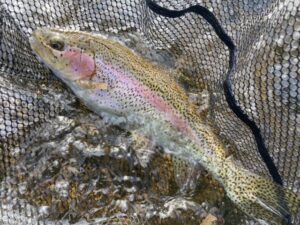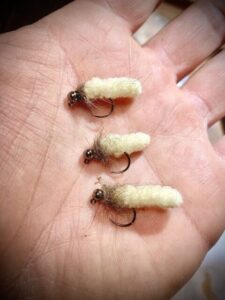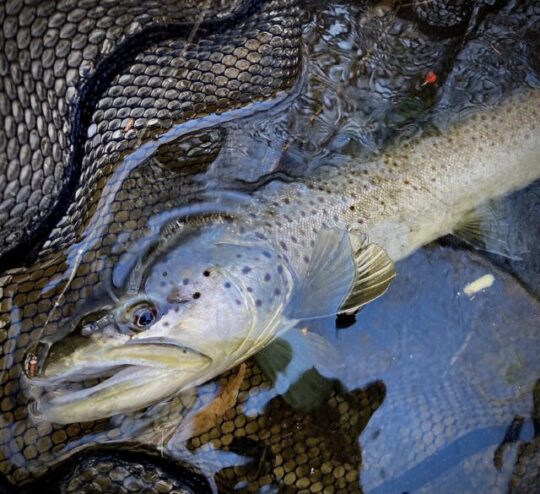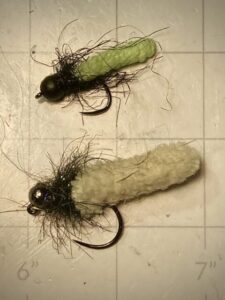
There’s no denying the effectiveness of the infamous Mop Fly. What other fly has been featured in the Wall Street Journal? “Fake news!” say the purists, and they’re right – literally.
We love to theorize what the Mop might represent; crane fly larva, caddis larva, beetle grubs, cigarette butts, Cheetos, the list goes on. If you’re a really good fisherman, you’ll refer to the Latin names ad nauseum.
But get that thing wet and it sure looks like something edible. I’m not sure it’s any more complicated than that. For what it’s worth, I think we sometimes give trout much more credit than they deserve in terms of intelligence (it’s the back-door approach to giving ourselves more credit than we deserve).
“Sophisticated” trout will eat a Mop Fly the same way “sophisticated” people will eat junk food. It has its moments. I’ve never tried one at night, but I have a feeling the Mop would work great around 2 am after last call.
I always carry an assortment and usually have one ready to go in my C&F working box. I’ve tried adding hot spots, but the basic version seems to work best for me: cream or off-white with a dark, buggy collar and a black or black-nickel bead.
However, the Mop can do a lot more than fool stockies and the occasional wild trout on a junk food binge. Used as an anchor or “point” fly, the Mop can help deliver smaller, lighter, and more natural patterns differently than faster sinking, more dense alternatives.

Recently, I worked a stretch of river, alternating between suspension nymphing under a yarn indicator and tightline nymphing. I rotated midge and small caddis larva/pupa patterns on a three-fly rig with no takes.
Moving past some pocket water, I paused for a minute, thinking there would likely be one or two willing rainbows.

I replaced my point fly with a Mop, made a cast to the most likely target and was quickly tight to a nicely-colored winter rainbow. However, to my surprise, it refused the Mop and instead ate a size 18 caddis larva on the middle dropper.
Next, I headed toward a soft seam adjacent to a slow riffle. Making a few casts along the way, I could easily see the Mop as it drifted back toward me. It flowed naturally with the current, not dredging or getting hung on the bottom.
Now, in position to make a good cast, the weight of the soaked Mop Fly carried the rig well above my target. Its buoyant properties maintained a nice drift into the anticipated strike zone.

I set the hook, the rod bent, and a few head shakes told me I was tight to a good fish. I could see the Mop trailing behind as I let the big brown tire upstream in the current.
This example is by no means an isolated event and far better anglers than me have suggested the Mop Fly can sometimes fool a few more fish by changing the dynamics of your drift.
That said, here are a few considerations:
- You can tie lightly-weighted mops that will cast a long way on a tightline rig because the water-logged chenille becomes heavy. Nevertheless, the buoyancy of the chenille produces a nice, natural drift. Weighted correctly, it doesn’t sink like a stone or dredge bottom, and sometimes, that’s the better presentation. Those benefits transfer to the dropper flies on your rig as well, and the Mop Fly becomes a nice delivery tool for small, lightweight droppers. I like to consider this as a sort of “underwater opposite” of a floating suspension device (indicator), such as yarn or a bobber. Basically, it’s a sunken indicator.
- Similarly, the Mop is highly visible, and you can often track it through the water to judge drift qualities, such as pace and depth. Weighted egg and worm patterns can also be employed in this fashion.
- The Mop can be an attractor that draws the attention of fish, which may prefer to take the smaller offering on the dropper tag. But this could just as easily work against you, so keep that in mind. For that reason, I often switch to the Mop after fishing other methods. They can also make a bit of commotion when they hit the water (like a wet mop) and in some settings, that may spook fish. However, the distance they can achieve might allow you to aim above your target as I did in the example.
- Another reason to have some lightweight Mops: During high water, fish will move to the softer edges and current breaks where not much weight is required to reach depth. Also, flies silhouetted against the sky are easier for fish to see in stained water, so drifting a bit higher in the column can be a good tactic.
So how light is “light?” A 3.5 mm tungsten bead without lead wire makes a versatile fly, but I tie them unweighted all the way up to 4mm with added lead. You can experiment by adjusting the weight up or down as well as the length of the chenille.

A “Mini Mop” tied with “mini”-sized chenille provides a smaller profile. Of course, a heavy Mop fished deep in the fast water has its time and place also.
I hope this inspires you to think a bit more about how to employ the Mop Fly. Try them in a variety of weights and keep them in the rotation, especially when you think a change-up is in order.
Finally, congratulations and thanks to all who helped the blog achieve one million views!
-Tight lines.
Discover more from BlogFlyFish.com
Subscribe to get the latest posts sent to your email.

Good article. While many sing its praise, the mop is one fly I have fished with little success, even for Brookies in Maine.
Now the Squirmy…….! That’s one I have come to love in the spring.
The squirmy is your mop – confidence is key.
Excellent points, Damon. I think your observation about the mop as an underwater suspension device is really helpful. To Steve’s point, mops seem to be feast or famine for me. Sometimes trout hit em like Teddy B hits running backs, but sometimes fish avoid them like I avoid a cougher during the COVID pandemic. It usually doesn’t take too long to find out how the trout feel about them.
Thanks, Bill. Sometimes it pays to give the mop a few drifts after you think the well has dried up…
Damon, after reading your article I will give the mop fly a go. I have never fished them before, but I can see how they can resemble a lot of larvae. Last fall while fishing I went to pick up for the next cast and there was something on my fly as I could feel the added weight. On the hook point perfectly impaled was a crane fly larva that I had somehow hooked. A mop fly would make for a darned good imitation of it. I left the “bait” on for a few drifts, but got no takers before it fell off.
Best, Sam
I’ve hooked cased caddis many times, but never a crane fly larva. It was good of you to attempt to return the poor larva back to its original home…
Nice write up Damon. I dabbled in many of the things you articulated so well this fall- only with an egg fly instead of a mop. It was fun to explore the depth, speed, and quality of presentations with and without an floating indicator. Using a visible sunken fly to take the place of a floating indicator really seemed to make for a better presentation.
Thanks, Jamie. I fish egg patterns a lot and like you said, they can have similar properties underwater.